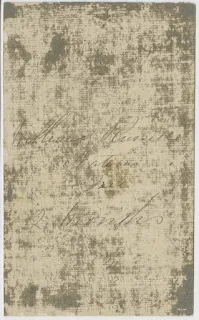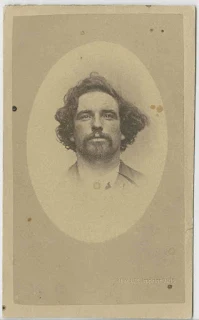MUGSHOT of PRISONER WILLIAM RUSSELL
Stereograph by Thomas J Nevin bottom of page 270
Catalogue for the exhibition The Photograph and Australia, Judith Annear (ed)
Art Gallery of NSW, 21 March - 8 June 2015.
Photo copyright © KLW NFC 2015 ARR
The Stereograph
Of the many dozens of stereographs taken by Thomas J. Nevin in the late 1860s which are held in the Tasmanian Museum and Art Gallery collections, this particular one was chosen for display at The Photograph and Australia exhibition, Art Gallery of NSW, 21 March - 8 June 2015.
The Exhibition catalogue on page 296 lists the stereograph with these details:
"Thomas J Nevin
Elizabeth St 1860s
stereograph
7.3 x 7 cm (each)
8.5 x 17.4 cm (card)
Tasmanian Museum and Art Gallery, Hobart
Q1994.56.12"

The old TMAG database (online until 2006) listed this stereograph with these details:
Tasmanian Museum and Art Gallery Ref: Q1994.56.12
Sepia stereoscope salt paper print
T . Nevin [Artist] 1860s late
Hobart from near 140 Elizabeth Street on corner Patrick ? Street.
Nevin & Smith photographic Studio in buildings on extreme right [refer also to Q1994.56.33]
Impress on front: T Nevin/ photo
The reference to another stereograph of a similar view in the old TMAG database entry (above) is to this one, Q1994.56.33, (below) which depicts the same line of buildings, including Thomas Nevin's studio located at 140 Elizabeth Street, Hobart, just "three doors from Patrick Street" according to press advertisements by the studio's former operator until 1867, Alfred Bock. The studio at No. 140 with the business name of The City Photographic Establishment and the shop and residence were separated by an entrance leading to the glasshouse at No. 138½, visible in both captures this side of the pavement overhang as the street begins its descent to the wharves.
This stereograph (below) was taken at a different time from the one displayed at the AGNSW, and possibly taken with a different stereoscopic camera. The horse and cart, the man in a light suit standing next to a lamp post on the corner of Patrick and Elizabeth Street, and the side of the building partially displaying the merchant's name "Lovell (?) " who sold pianos - all are missing - yet this second capture adds no more to the line of buildings on the other side of the street than the one above, despite being photographed from a greater distance. Both stereographs were framed in an arched buff mount.
This second stereograph was not stamped by Nevin, unlike the one above which carries his blindstamp impress lower centre between the two images. The stamping of one, and not the other of a similar set-up, appears to have been his common practice. When Nevin took two or more photographs depicting similar scenes, he stamped one either recto or verso, and left the second one blank. Compare this pair of two slightly different stereographs of Elizabeth Street with his pair of two slightly different stereographs of visitors/surveyors to the Salt Caves at Victoria, Huon Valley.
The reasons behind this practice may vary from experimentation with one, so no need for a stamp, and satisfaction with the other according to the client who commissioned it on commercial terms, hence the stamp. Further copies of the same photograph or those of similar subjects were included as a further possibility for the same commission fee. One stamped photograph per batch of 100 or per a yearly fee was required by photographers to register copyright of a particular trademark with the Office of the Registrar of Patents, Customs House, Hobart. Tasmanian photographers' copyright of their work was regulated by the Registration of Trade Marks Act 28, No. 6, Victoria, from 1864. Only two copies of their trade mark, applied to the "goods" they were intended to protect were required to be deposited with the Registrar. The applicant was issued with a one year Provisional Certificate, and if no objection was raised, the copyright endured absolute for a period of 14 years. Nevin registered copyright of at least six commercial trademarks and at least one of his trademarks, registered under colonial warrant and featuring the Supreme Court's Royal Arms insignia, was held jointly when commissioned by the Hobart City Council. This pair of slightly different stereographs of the same scene taken at different times, like those taken at the Salt Caves, are most likely estrays from the Lands and Survey Department, supplied at the request of James Erskine Calder, Surveyor-General.

Stereograph by Thomas J. Nevin ca. 1868
140 Elizabeth St. Hobart showing Nevin's studio, formerly Alfred Bock's, "three doors from Patrick St."
Tasmanian Museum and Art Gallery, Ref: Q1994.56.33.
Photo taken at TMAG 10th November 2014
Photo copyright © KLW NFC 2014 ARR

Verso: Stereograph by Thomas J. Nevin ca. 1868
140 Elizabeth St. Hobart showing Nevin's studio, formerly Alfred Bock's, "three doors from Patrick St."
Tasmanian Museum and Art Gallery, Ref: Q1994.56.33.
Photo taken at TMAG 10th November 2014
Photo copyright © KLW NFC 2014 ARR
The Mugshot
One reviewer of the exhibition The Photograph and Australia has noted the lack of mugshots apart from Ned Kelly's rap sheet bearing two photographs. Others which were included were not identified as such. This vignette by Thomas Nevin of William Russell, who was imprisoned for two months in 1882, is a case in point, despite the fact that the Tasmanian Museum and Art Gallery submitted it as a prisoner mugshot with the detail of Russell's prison sentence written on the verso, albeit unattributed.

Exhibited at the AGNSW 2015
Details per page 299 of Catalogue, The Photograph and Australia
"William Rusille (?) /native/free (?) /2 months c 1874The AGNSW exhibitors have transcribed information from barely legible details on the verso of this photograph, but added the date "1874" through a common misconception. The date "1874" ascribed to this photograph is an error. It is a date which has been routinely applied to all carte-de-visite mounted photographs of Tasmanian prisoners/convicts held in public collections when nothing is known of the prisoner's history at the time the photograph was taken. It is an error caused by an early 20th century exhibitor who wrote "Taken at Port Arthur 1874" across the versos of the extant 300 or so cdvs of "convicts" purely in the interests of government-sponsored penal heritage tourism in the 1920s to coincide with the making of the film For The Term of His Natural Life at Port Arthur, based on Marcus Clarke's 1874 novel.
carte-de-visite
10.3 x 6.3 cm (card)
Tasmanian Museum and Art Gallery, Hobart
Q15623"


Recto and verso of mugshot of William Russell
There is no date inscribed on verso.
TMAG Collection: Ref: Q15623
This prisoner, Willliam Russell, was photographed once on incarceration in February 1882 at the Hobart Gaol. He was tried at Hobart on 17th February 1882 for unlawfully beating, sentenced to two months, and discharged on 19th April 1882. He was listed as Free, born in Tasmania ca. 1856, and bearing an unusual tattoo on his upper right arm: "EYGM". The police gazette* record of his age and height was corrected a week later on 28th April 1882.
This photograph, the booking shot, which was printed first as a vignette (cloudy background), was reprinted in an oval mount two month's later, in April 1882, when William Russell was discharged. For such a short sentence of two months, when the prisoner's physical appearance is unlikely to have changed, a reprint of the booking shot rather than a new photograph seems to have satisfied police requirements. The unusual feature of this photograph and many others printed for gaol records right up to the last of Thomas Nevin's involvement with prisoner identification photography in 1888 is the use of an oval mount typical of his earlier commercial practice. Only the full frontal gaze had changed from the earlier pose with the prisoner's eyelines deflected to left or right of the frame.
Taken by Constable John Nevin and Thomas J. Nevin, February 1882, Hobart Gaol.
*Source: Tasmania Reports of Crimes Information for Police, J. Barnard, Gov't Printer.
